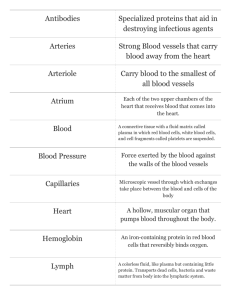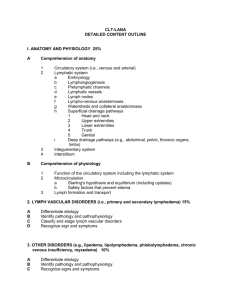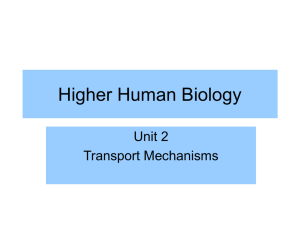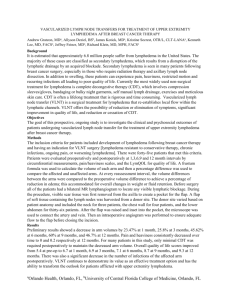Lymphedema Management - Turning Pointe Physical Therapy, Inc.
advertisement
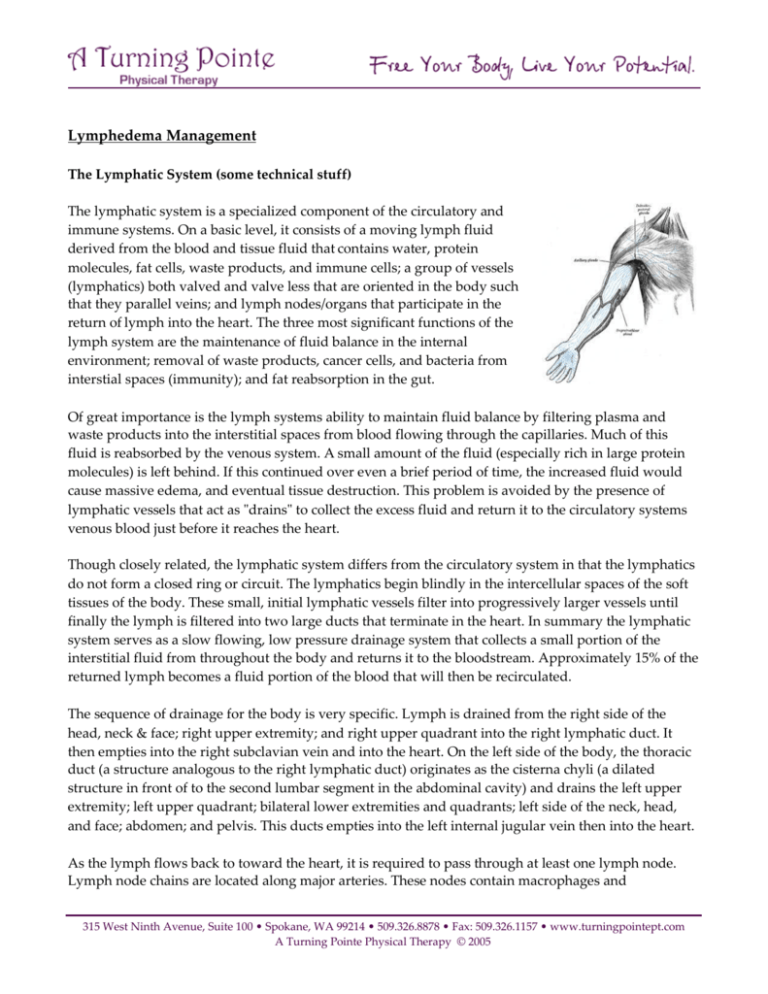
Lymphedema Management The Lymphatic System (some technical stuff) The lymphatic system is a specialized component of the circulatory and immune systems. On a basic level, it consists of a moving lymph fluid derived from the blood and tissue fluid that contains water, protein molecules, fat cells, waste products, and immune cells; a group of vessels (lymphatics) both valved and valve less that are oriented in the body such that they parallel veins; and lymph nodes/organs that participate in the return of lymph into the heart. The three most significant functions of the lymph system are the maintenance of fluid balance in the internal environment; removal of waste products, cancer cells, and bacteria from interstial spaces (immunity); and fat reabsorption in the gut. Of great importance is the lymph systems ability to maintain fluid balance by filtering plasma and waste products into the interstitial spaces from blood flowing through the capillaries. Much of this fluid is reabsorbed by the venous system. A small amount of the fluid (especially rich in large protein molecules) is left behind. If this continued over even a brief period of time, the increased fluid would cause massive edema, and eventual tissue destruction. This problem is avoided by the presence of lymphatic vessels that act as "drains" to collect the excess fluid and return it to the circulatory systems venous blood just before it reaches the heart. Though closely related, the lymphatic system differs from the circulatory system in that the lymphatics do not form a closed ring or circuit. The lymphatics begin blindly in the intercellular spaces of the soft tissues of the body. These small, initial lymphatic vessels filter into progressively larger vessels until finally the lymph is filtered into two large ducts that terminate in the heart. In summary the lymphatic system serves as a slow flowing, low pressure drainage system that collects a small portion of the interstitial fluid from throughout the body and returns it to the bloodstream. Approximately 15% of the returned lymph becomes a fluid portion of the blood that will then be recirculated. The sequence of drainage for the body is very specific. Lymph is drained from the right side of the head, neck & face; right upper extremity; and right upper quadrant into the right lymphatic duct. It then empties into the right subclavian vein and into the heart. On the left side of the body, the thoracic duct (a structure analogous to the right lymphatic duct) originates as the cisterna chyli (a dilated structure in front of to the second lumbar segment in the abdominal cavity) and drains the left upper extremity; left upper quadrant; bilateral lower extremities and quadrants; left side of the neck, head, and face; abdomen; and pelvis. This ducts empties into the left internal jugular vein then into the heart. As the lymph flows back to toward the heart, it is required to pass through at least one lymph node. Lymph node chains are located along major arteries. These nodes contain macrophages and 315 West Ninth Avenue, Suite 100 • Spokane, WA 99214 • 509.326.8878 • Fax: 509.326.1157 • www.turningpointept.com A Turning Pointe Physical Therapy © 2005 lymphocytes (immune cells used to prevent illness). Locations of nodes include: the axilla, clavicle, side of the neck/head, inguinal area, abdominal wall, pelvic region, mesenteric region, popliteal fossa, medial thigh, breast, and antecubital fossa. The body also includes some specialized lymphatic organs including the tonsils, thymus, Briers patch of the liver, bone marrow, and the spleen. Functions of Lymphatic Vessels Lymphatics play a critical role in homeostasis of the body. The high degree of capillary permeability permits large molecular weight substances that cannot be absorbed by the blood capillaries to be removed from the interstitial spaces by the lymphatics. Proteins that accumulate in the interstitial spaces can return to the blood only via the lymphatics. In fact, each day about 50% of the total blood proteins leak out of the capillaries into the tissue and return to the blood via the lymphatic vessels. This is of great clinical importance, because if anything blocks lymphatic return, blood protein and blood osmotic pressure will fall below normal and fluid imbalance and death will result. The Lymphatic Pump Though no central pump is present to propagate the flow of lymph fluid onward to the heart, the larger, deep lymphatic vessels contain muscular walls (lymph-angion segment) that pump fluid directionally via peristalsis. Lymph flows through the thoracic duct and reenters the general circulation at the rate of 125 mL/hour. This continues despite the fact that most of the flow is against gravity or "uphill". This is partially a result of the large number of muscular vessels, but also due to breathing movements and skeletal muscle contractions. X-rays show that lymph fluid pours into the central veins most rapidly at the peak of inspiration. The mechanism of inspiration, as dictated by the descent of the diaphragm, causes intraabdominal pressure to increase as intrathoracic pressure decreases. This simultaneously evokes a pressure increase in the abdominal portion of the thoracic duct and a decrease in the thoracic portion. Research has shown that thoracic duct lymph fluid is literally "pumped" into the venous system during inspiration. The rate of flow of lymph into venous circulation is proportional to the depth of inspiration and the total volume of lymph that enters the central veins during a given time period depends on both the depth of inspiration and the overall breathing rate. Other pressures that have been indicated in generating lymphatic flow include: arterial pulsations, postural changes, passive compression (massage) of the body soft tissues, and muscular contractions. In regard to muscular activities and the affect on the lymph system, contracting skeletal muscles exert pressure on the lymphatics to push the lymph forward. These lymph-circulating exercises are called 315 West Ninth Avenue, Suite 100 • Spokane, WA 99214 • 509.326.8878 • Fax: 509.326.1157 • www.turningpointept.com A Turning Pointe Physical Therapy © 2005 lymphokinetic actions. . Flow can be so increased that during exercise, it may be as much as 10-15 times its normal rate. As evidenced by the above examples, the lymphatic system is a complex body system that is considered single and distinct, yet it interacts with several of the other body systems. Researchers have found connections of the lymph system not only with the circulatory, respiratory, and musculoskeletal systems, but the digestive and nervous systems are also related. In relation to the digestive system, the lymphatic system plays a critical roll. Small quantities of small fatty acids are able to directly enter the intestinal capillaries of the small intestine and then enter the blood stream. The majority of fatty acids, however, are long chained and are absorbed very differently. Within the intestinal lumen, bile salts form water-soluble aggregates that collect fatty acids. The fatty acids and monoglycerides are transported to the brush borders of the villi. From here, they disperse into the epithelial cells of the villi, then continue their transport function in the intestinal lumen. Within the epithelial cells, the fatty acids and monoglycerides are reformed into triglycerides. The triglycerides combine with cholesterol, lipoprotein, and phospholipids to form globules. These globules leave the epithelial cells and enter into the lacteal of the villus. Lymphatic vessels then carry the globules by way of the thoracic duct to the venous blood of the left subclavian vein. In this light, it is easier to understand why individuals with digestive disorders can have secondary lymphedema of the abdomen and extremities. The nervous system, though directly related to the lymphatics is not often discussed. The most common observation of the interrelationship of the nervous and lymph systems is seen in cases of traumatic brain injury, spinal cord injury, or other neurovascular conditions. In these situations, atrophy of the deep lymphatic vessel musculature results in paralysis of the lymphatic flow. Swelling in the legs and abdomen are often the end result. When the legs are placed above the heart (out of a dependent position) some of this edema temporarily resolves. Edema The lymphatics help to remove the excess fluid and protein that enters the tissues from, damaged (leaky) blood vessels, in any inflammation (e.g. after a burn or other injury). If the lymphatics are not efficient in this process, the area will swell (edema). This swelling is usually only temporary, because the tissues heal and the blood vessels no longer leak excessively. In an acute injury, e.g. a sprained ankle, the lymphatics are essentially normal. Although there is initial swelling, this is gradually removed over days to weeks. Though, the overload is only temporary, depending on the severity of the injury, some fibrosis will occur. This may remain for months or even permanently. 315 West Ninth Avenue, Suite 100 • Spokane, WA 99214 • 509.326.8878 • Fax: 509.326.1157 • www.turningpointept.com A Turning Pointe Physical Therapy © 2005 Lymphedema If the lymphatic system is chronically damaged or blocked, protein continues to enter the tissues from the blood capillaries in a normal fashion, but a build-up occurs in the tissue. When lymphatics fail to drain appropriately, the accumulation of protein in the tissues results in excess fluid inside the tissues bringing about stagnation, swelling, and a decrease of lymphatic return. Since this excess fluid is protein-rich, it acts as a stimulus for chronic inflammation. Inflammation along with fibrosis (scarring) decreases oxygenation of the surrounding tissues instigating more blood capillaries to form and to be dilated. Resultant areas are often described as feeling hot and full. Normal functioning then ceases and tissue healing slows. This heat, combined with the stagnant protein provides a perfect site for bacterial growth. The individual may be very ill, with constant infections, and need hospitalization. Fungal infections are also very frequent, and are often difficult to clear up. These infections, themselves, place greater loads on the lymphatics, and so worsen the lymphedema. Any infection or other inflammation (e.g. subsequent injury, sunburn, etc.) makes the lymphedema worse. If the swelling is rapid, it can cause great pain due to the rapid expansion of the tissues. Adjacent areas, which are receiving excess lymph diverted from the blocked region, frequently ache (e.g. the shoulder adjacent to an edematous arm). If swelling is slow, there may be no pain at all, except during bouts of infection. Lymphedema has a number of other effects: it decrease mobility and function (secondary to tissue fullness), leads to embarrassment that can trigger depression, and causes a general worsening of the patient's health and quality of life. If the lymphedema is severe, with more than one limb involved, the patient is often markedly heavy secondary to the excess fluid. Lymphedema is often diagnosed as a chronic swelling in one or both extremities (arm or leg). However, since lymph vessels, nodes, and organs are scattered throughout the body, any organ or region may suffer. Other common areas of swelling include the genitals, the abdomen, the lungs, and the liver as a consequence of chronic hepatitis. Types of lymphedema Primary (lack or dysfunction of lymphatic vessels) Usually there are simply too few lymphatics; sometimes there are many, but they are very dilated and do not pump properly; sometimes it is a combination of both. This type of lymphedema can appear before birth, during puberty, which is the most common form of primary lymphedema, or later in life, e.g. from 30-40 onwards. Occasionally there is a narrowing of one of the major lymph trunks, e.g. at the outlet of the thoracic duct. 315 West Ninth Avenue, Suite 100 • Spokane, WA 99214 • 509.326.8878 • Fax: 509.326.1157 • www.turningpointept.com A Turning Pointe Physical Therapy © 2005 Secondary (blocked or cut lymphatic vessels) Secondary lymphedema can occur if the lymphatic drainage is blocked or cut, from: Surgery, especially for carcinoma with the removal of lymph nodes or tissue (e.g. an operation for melanoma) where many lymphatics are cut. Radiation therapy, used to kill tumor cells, destroys the lymph nodes and blocking them with fibrous tissue. Accidental trauma may tear lymphatic vessels, which may not rejoin after the blood vessels heal; any excess fibrous tissue caused by the damage can later shrink and constrict them. Parasites (e.g. filarial worms) block lymphatic drainage. The swelling may occur when the worms grow, damage the lymphatics, and destroy their valves. Paralysis of a limb prevents lymphatic pumping. Often paralyzed individuals who are wheelchair bound have dependent edema. Chronic venous insufficiency often involves the lymphatics running beside the veins, thus eventually adding lymphedema to the venous edema. Lipodema (this is not itself lymphedema, but can cause it secondarily) Incidence In the United States, the highest incidence of lymphedema is observed following breast cancer surgery. Among this population, 10-40% develop some degree of upper extremity (arm) lymphedema. This increases to about 52% after radiation therapy. Worldwide, 140-250 million cases of lymphedema are estimated to exist, with filariasis being the most common cause. Accepted Treatment This is called Complex Physical Therapy (C.P.T.) because a number of physical therapeutic approaches are combined to produce the results. (It is also called 'Complex Lymphatic (or) Lymphedema Therapy' C.L.T. - or 'Complex Decongestive Physical Therapy' - C.D.P.T.) It achieves the fastest reduction of lymphedema. This is most effective if the individual is experiencing an acute flare-up versus lymphedema present for a number of years. The latter implicates a more complex buildup of scar tissue. 315 West Ninth Avenue, Suite 100 • Spokane, WA 99214 • 509.326.8878 • Fax: 509.326.1157 • www.turningpointept.com A Turning Pointe Physical Therapy © 2005 C.P.T. consists of four main parts: Skin care to prevent any infection adding to the lymphatic load and to improve the skin condition. The most important aspect of skin care is scar tissue massage. This massage is done to increase mobility of post-surgical scar tissue and toughened tissue from radiation therapy to allow freer passage of the lymph through these areas. Specialized massage, which removes the excess fluid and protein and opens collateral lymphatics so that unaffected regions can drain the affected area. This massage is restricted to work on the skin layer only. Therefore, pressure applied is just enough to stretch the skin in a particular direction to encourage lymphatic flow. Patients are taught how to perform their own clearings at home to enhance lymphatic efficiency. Clearing follow the drainage patterns and always work proximally (chest and abdomen) before working the extremities. In addition, the extremities are worked distal to proximal to enhance flow toward the heart. Compression bandages and compression garment worn on the affected limb to maintain the reduced size and to decrease tissue fibrosis. Specific exercises to supplement the massage and increase lymphatic drainage. Deep breathing (to encourage pumping of the cisterna chyli) as well as cardiovascular exercise has been shown to increase lymph drainage by 10 to 15X. Other therapeutic interventions can be incorporated including: releasing tightened muscles tissue often due to muscle guarding or tissue injury after surgery, improving posture to enhance maximal drainage of the system, and gait training for individuals with bilateral lower extremity lymphedema. CONDITIONS & SYMPTOMS THAT BENEFIT FROM LYMPHEDEMA MANAGEMENT Congenital conditions causing primary lymphedema Complications from surgery and radiation for various types of cancer leading to secondary lymphedema (often present in the neck, chest, arm(s), trunk, leg(s), and/or feet) Non-infected inflammatory conditions (sprains/strains) Vascular & arterial insufficiency leading to leg swelling Sports injuries (joint dislocations, contusions, fractures, & over use syndromes) Burns (radiation or other) 315 West Ninth Avenue, Suite 100 • Spokane, WA 99214 • 509.326.8878 • Fax: 509.326.1157 • www.turningpointept.com A Turning Pointe Physical Therapy © 2005 Pre and post surgery Chronic Inflammatory conditions (auto-immune) 315 West Ninth Avenue, Suite 100 • Spokane, WA 99214 • 509.326.8878 • Fax: 509.326.1157 • www.turningpointept.com A Turning Pointe Physical Therapy © 2005


